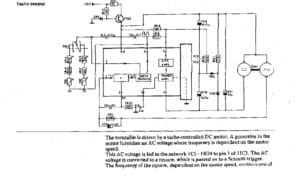Forum Replies Created
-
AuthorPosts
-
hcraig244
SILVER MemberI have found a number of these random intermittent faults have been caused by the switches feeding the logic gates within the control panel, the logic chips are very reliable and seldom, if ever fail….the switches feeding the gates however are very susceptible to fail…typically arc and corrosion, and also bending over time…if a leaf type switch is left stood in one position for a long time it will loose some of its elasticity. The switch that controls the lower current to the magnetic coil is one such switch, if this is not clean and fully functional it could cause the issue you describe, also clean and inspect the control panel switches….have a read of the training notes donated by Solderon in the manuals section of the products area…..they are very informative.
Good luck!
hcraig244
SILVER MemberWhen you say it only happens in the first 1/3 of the record does it always happen at the same point each time it occurs?
19 November 2025 at 09:10 in reply to: Beomaster 3000-2 Type 2402 15V Power Supply Not Activating #71379hcraig244
SILVER Membergood work….sounds like the red herring thrown up by the DBT is resolved, regarding zapping something if you power up I suspect the offending component will have been zapped sometime ago when the problem first arose, again if you have a variac (very useful for fault finding) try disconnecting the 15v supply from the circuit somewhere around halfway through and power up the 240v slowly monitoring the current pull (put your DVM in series) as you do so…..if the current starts to go up alarmingly the fault is in the part of the circuit connected…..check all components
Good luck
-
This reply was modified 2 weeks, 4 days ago by
hcraig244.
13 November 2025 at 08:37 in reply to: Beomaster 3000-2 Type 2402 15V Power Supply Not Activating #71126hcraig244
SILVER MemberOne other thing…..the circuit diagram shows 22vac from the transormer to the 15vdc rectifier…..your measuring 17.6vac
made a proper bollocks of the images i know ;¬)-
This reply was modified 3 weeks, 3 days ago by
hcraig244.
-
This reply was modified 3 weeks, 3 days ago by
hcraig244.
-
This reply was modified 3 weeks, 3 days ago by
hcraig244.
Attachments:
You must be logged in to view attached files.13 November 2025 at 08:26 in reply to: Beomaster 3000-2 Type 2402 15V Power Supply Not Activating #71124hcraig244
SILVER Memberyou have replaced or proved every component in the circuit, confirmed every track and solder joint all to no avail….the only outstanding item is your transformer….do you have a variac you could power the 15v rectifier from?……you have eliminated every other component in what is a basic power supply circuit….i keep thinking of the fact that the circuit performs correctly on power down….back emf from the transformer, if that’s even possible, could be doing this……there isn’t anything else to check ;¬)
Craig
12 November 2025 at 08:17 in reply to: Beomaster 3000-2 Type 2402 15V Power Supply Not Activating #71104hcraig244
SILVER Membercould that brief spike be back emf from the transformer when it shuts down….i have to agree this isnt making much sense, you have changed the smoothing cap and bridge rectifier…cap is in the correct polarity, have you powered up without the DBT on the supply?
Craig
10 November 2025 at 12:54 in reply to: Beomaster 3000-2 Type 2402 15V Power Supply Not Activating #71022hcraig244
SILVER MemberSounds like some progress…..change TR17 out and you should be good to go for the FM issue, dillen from the site always advocates the “half it” approach which is to go half way into the circuit and disconnect/test then work back or forth from that position…..always works for me ;¬)
Craig
hcraig244
SILVER MemberHi
just seen your post, this can most likely be repaired, see my post in the forums for Beovox for the procedure
hcraig
hcraig244
SILVER MemberNot quite sure what your describing here….do you mean the tone arm?….or something else?
Craig
7 November 2025 at 13:11 in reply to: Beomaster 3000-2 Type 2402 15V Power Supply Not Activating #70966hcraig244
SILVER MemberAlso bear in mind that some components can measure up fine when tested, but fail under load…..I’ve had this issue in the past, and replacement parts from suspect suppliers should be avoided…early transistors can still be found as old stock and are a safer bet than ebay
Craig
7 November 2025 at 13:07 in reply to: Beomaster 3000-2 Type 2402 15V Power Supply Not Activating #70965hcraig244
SILVER Memberif you disconnect all users from the 15v power supply rail and measure the output is the problem still present?
Craig
6 November 2025 at 21:01 in reply to: Beomaster 3000-2 Type 2402 15V Power Supply Not Activating #70961hcraig244
SILVER MemberHave you checked for broken traces and dry joints…..it’s got to be something obscure 👀
5 November 2025 at 14:55 in reply to: Beomaster 3000-2 Type 2402 15V Power Supply Not Activating #70934hcraig244
SILVER MemberReplace ZF9,1V……..see if that helps, if not then at least you can eliminate it from the problem
Craig
hcraig244
SILVER MemberIve had to think hard about this reply so as not to offend anyone who has been good enough to give you the technical advice your currently in receipt of, however it appears said advice is condemning a valuable deck in a somewhat off hand manner. The power supply stabilisers and associated reed relays are a little daunting but they can be repaired/restored…even the relay coils can be rewound….I have no doubt Nick is the man for the job…..given his B&O service engineer background ;¬)
hcraig244
SILVER Memberhcraig244
SILVER MemberI dont understand that last post?
hcraig244
SILVER MemberOk…..when you press start does the turn table rotate?…..also as Mark suggests does the transport motor drive with the belt removed, if so this would prove a fair amount of the unit is operational….hopefully it is an issue withthe belt slipping as this will be an easy fix for you…
Craig
hcraig244
SILVER MemberIts unlikely that lubricating the carriage drive screw and associated wheel would cause the problems you describe, I would take a close look at the carriage position sensor and ensure it hasn’t become detached or damaged..see the attached blog from the beolover….his issue was different to yours but i suspect it could be related…send some pics of your unit for us to view
https://beolover.blogspot.com/2016/04/beogram-4002-5513-non-working-end-groove-detection.html
hcraig244
SILVER MemberStephen
where are you located….
craig
-
This reply was modified 2 weeks, 4 days ago by
-
AuthorPosts

